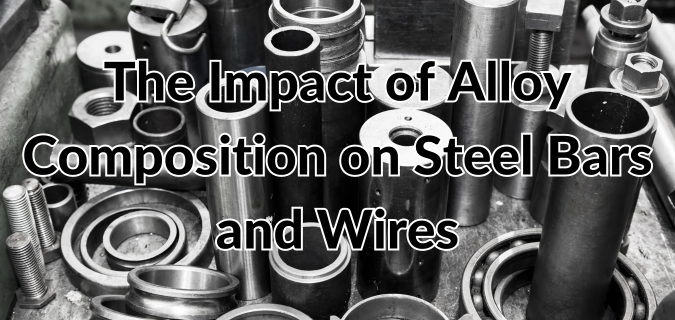
Among many other positive qualities, steel is versatile, durable, and 100% recyclable. A large reason for all of this is alloys. Depending on the composition of the alloy, manufacturers can adjust hardness, toughness, strength, ductility, conductivity, density, and more, as well as increase corrosion resistance.
It’s a big topic, so we’ll start with an overview of what a steel alloy is, how different alloys serve different purposes, and a few of the most common elements used in steel alloys.
What is Steel Alloy Composition?
Steel is an iron-based material. Alloy steel is when other elements are added—that is, alloyed—to steel for specific purposes. Alloy steels are created to, among other applications, increase strength or hardness, resist wear or corrosion, improve thermal conductivity, and withstand high temperatures. Alloy steel composition consists primarily of iron, a small amount of carbon, usually some residual copper, and whatever elements, in precise amounts, are needed to create the desired properties of the steel alloy. For example, an alloy needs to be at least 10.5% chromium to be considered stainless steel. When we mention percentages, we’re specifically referring to the percentage by weight of the elements.
Different elements serve different purposes in alloying steel. To list a few properties of alloys: chromium is often added to improve corrosion resistance, nickel adds strength, particularly at high temperatures, and carbon, which is always present in steel and technically is not an alloy (usually less than a quarter of a percent), can be intentionally added to increase hardness. Several other alloying elements—nitrogen, manganese, copper, silicon, molybdenum, titanium, aluminum, and cobalt—have their own alloy steel properties, often working in conjunction with other elements.
Alloying Elements and Their Influence on Steel
Steel can be classified into many different groups, depending on how specific you want to get. At the broadest level, there’s carbon steel, in which nothing additional has been added to the steel, and alloy steel, which can then be further classified into multiple categories depending on the specific applications. Low-alloy steel contains fewer than 8% by weight of alloying elements, and high-alloy steel will have 8% or more alloying elements.
Alloy steel vs. stainless steel? It’s not necessarily one or the other. Alloy steel is a type of high-alloy steel in that the chromium content alone is at least 10.5% by weight.
Tool steel, another type of high-alloy steel, has a high carbon content among other alloys to make tough, durable tools that resist wear.
This is far from an exhaustive list, as manufacturers create many different types of steel alloys for intricately specific uses. The right steel for any project varies depending on the exact application. Here are some of the most common alloying elements that address some of the most wanted attributes in steel:
Chromium and Corrosion Resistance
With any iron-based product, corrosion is a possibility, so one of the most desirable attributes in alloyed steel is corrosion resistance. Chromium is the best alloying element that fights corrosion and the key to reaching stainless-steel status. As noted, an alloy must be at least 10.5% chromium to be considered stainless steel, but most stainless steels contain closer to 18% chromium.
Other elements that fight corrosion are nickel, nitrogen, copper, and aluminum, all of which are sometimes added for more specialized uses (for instance, copper might be used for steel in and around large bodies of water), but chromium remains the champion of corrosion resistance.
A lot goes into the proper alloy to fight corrosion. Environmental factors ranging from where in the world the steel is to fluctuating temperatures, specific uses, other alloying elements for other properties, and more contribute to how much of each element should be added into that particular alloy. Chromium is the most effective element in resisting corrosion, but manufacturers have to take into account all other factors to determine exactly how much chromium is best for the application at hand.
Manganese Strength
Manganese is one of the best elements for adding strength to steel. Manganese also hardens steel and helps to resist abrasion. When an alloy contains 12-14% manganese, it’s known as Hadfield steel, which is extremely wear-resistant and incredibly hard.
Although it might seem contradictory since manganese is so good at increasing hardness, manganese also helps with weldability, making it easier to form steel as needed for any application.
Nickel and Temperature Resistance
The two main reasons manufacturers add nickel to steel alloys are for increased strength at high temperatures and for formability.
Nickel alloys are often used in aerospace and chemical processing as the extremely high temperatures involved need steel that can withstand the intense heat.
Often, nickel is combined with other alloying elements to create specific properties. For instance, when combined with chromium, nickel helps steel (or stainless steel when there’s enough chromium) be exceedingly formable while also exhibiting superb corrosion resistance.
The Importance of Alloy Specifications
To state the obvious, steel alloy composition is complicated. Start with the elements themselves, all of which can improve steel in different ways. Then, consider that each element can affect the steel differently, when more or less abundant. When multiple elements are added to create even more specialized alloys and it can start to feel overwhelming.
Knowing the specifications of your alloys for your applications is important in ensuring your steel will perform at its best while also meeting and exceeding industry standards for safety, durability, and toughness.
Plus, as sustainable steel alloy production continues to evolve and improve, using the right alloys is particularly important when it comes to recycling steel, which is already one of the most recyclable materials in the world. This keeps costs and the environmental impact lower while raising the longevity and customer satisfaction of steel.
Make Informed Steel Decisions with Capital Steel
Need assistance figuring out which steel alloys are right for you? We have decades of experience and expertise in steel alloy composition and can help you sort through the vast options and help you determine which types of steel alloys are right for you. Contact us today to start the conversation.




